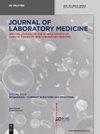Intensity-dependent stimulation of leukocyte telomerase activity by endurance exercise – a pilot study
IF 1.8
4区 医学
Q4 MEDICAL LABORATORY TECHNOLOGY
引用次数: 1
Abstract
Abstract Objectives Exercise induces telomerase activity and regulates shelterin expression. These effects are believed to preserve telomeres. However, the impact of exercise intensity on telomerase and shelterins has not been studied systematically. This pilot study investigated the kinetics of leukocyte telomerase activity (LTA) and the expression of telomere-related genes in response to exercise at different intensities. Methods Seven healthy women completed three exercise sessions at low, moderate and high intensity on a stationary bicycle ergometer. Blood was collected before, 24 and 48 h after each session. LTA, leukocyte telomere length (LTL), expression of telomerase reverse transcriptase (TERT), telomeric repeat binding factor 1 (TERF-1), 2 (TERF-2) and the serum concentration of telomeric repeat binding factor-1 protein (TRF-1) were determined. Results LTA increased 24 h after moderate and high intensity exercise and returned to baseline levels after 48 h. TERF-2 expression showed a tendency to decrease 24 h after high-intensity exercise. Other markers (TERT, TERF-1, LTL, TRF-1) were not affected by any intensity. Conclusions From the present results it can be concluded that the telomeric effects of exercise are short-lived and depend on the intensity level. Future studies should confirm these results in a larger cohort focusing on the first 24 h post-exercise.耐力运动对白细胞端粒酶活性的强度依赖性刺激-一项初步研究
目的运动诱导端粒酶活性,调节庇护蛋白的表达。这些作用被认为可以保护端粒。然而,运动强度对端粒酶和庇护蛋白的影响尚未有系统的研究。本初步研究探讨了不同强度运动对白细胞端粒酶活性(LTA)和端粒相关基因表达的影响。方法7名健康女性在固定式自行车测力仪上完成低、中、高强度3组运动。每次治疗前、24小时和48小时采集血液。检测LTA、白细胞端粒长度(LTL)、端粒酶逆转录酶(TERT)、端粒重复结合因子1 (TERF-1)、2 (TERF-2)表达及血清端粒重复结合因子-1蛋白(TRF-1)浓度。结果中高强度运动后24 h LTA升高,48 h后恢复至基线水平,高强度运动后24 h TERF-2表达呈下降趋势。其他标志物(TERT, TERF-1, LTL, TRF-1)不受任何强度的影响。结论运动对端粒的影响是短暂的,且与运动强度有关。未来的研究应该在更大的队列中确认这些结果,重点关注运动后的第一个24小时。
本文章由计算机程序翻译,如有差异,请以英文原文为准。
求助全文
约1分钟内获得全文
求助全文
来源期刊

Journal of Laboratory Medicine
Mathematics-Discrete Mathematics and Combinatorics
CiteScore
2.50
自引率
0.00%
发文量
39
审稿时长
10 weeks
期刊介绍:
The Journal of Laboratory Medicine (JLM) is a bi-monthly published journal that reports on the latest developments in laboratory medicine. Particular focus is placed on the diagnostic aspects of the clinical laboratory, although technical, regulatory, and educational topics are equally covered. The Journal specializes in the publication of high-standard, competent and timely review articles on clinical, methodological and pathogenic aspects of modern laboratory diagnostics. These reviews are critically reviewed by expert reviewers and JLM’s Associate Editors who are specialists in the various subdisciplines of laboratory medicine. In addition, JLM publishes original research articles, case reports, point/counterpoint articles and letters to the editor, all of which are peer reviewed by at least two experts in the field.
 求助内容:
求助内容: 应助结果提醒方式:
应助结果提醒方式:


